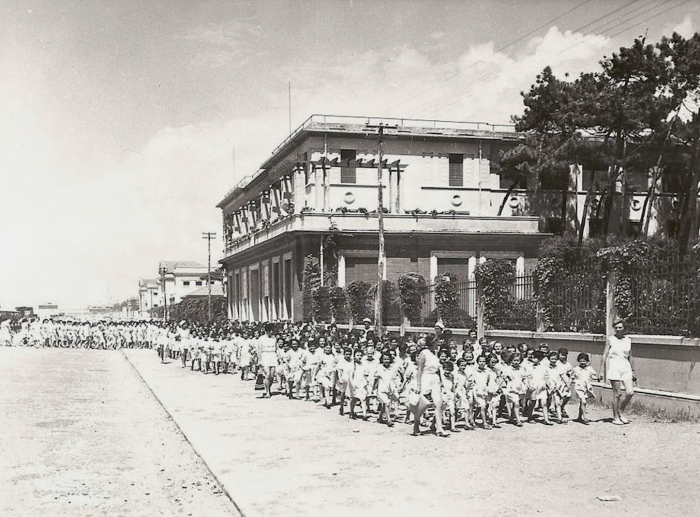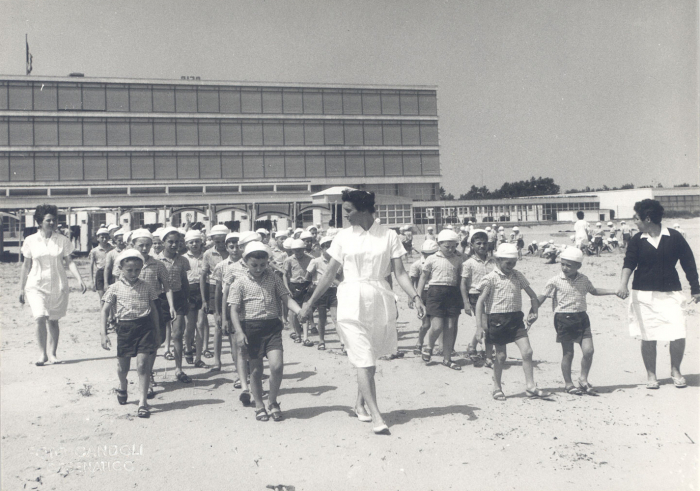The children’s camp was conceived during the fascist period as an integral part of the plan for healing the race and fascistizing society.
In particular, summer camps were intended for “indigent but basically healthy children”, while O.N.M.I. (National Charity for Maternity and Childhood) health centres and sanatoriums were directly in charge of the treatment of specific pathological affections.
Under the new regime, climate camps ceased to have strictly therapeutic purposes, inherited by Nineteenth century children’s homes, and were basically turned into sort of gymnasiums for the physical and spiritual training of the Fascist homo novus.
All the children were supervised and looked after, and great attention was paid to hygienics. At their arrival at the camp, they were supplied with all the clothes they needed for their stay. Assistance was highly regarded. Children were divided into teams according to their age or their physical development, and they also tried to group children of the same birthplace. Life in the camp was strictly regulated and children were looked after even during the shower. The day started with a salute to the flag placed on the beach, where children went marching. Then followed half-an-hour exercises and breakfast in the dining-hall. After breakfast, children enjoyed an hour of freedom during which they were actually taught the fascist doctrine. Afterwards children went back to the beach for the treatments – consisting of an air bath, a sunbathe and a bath in the sea. During the air bath, they should breathe and relax under the canopies that sheltered them from the sun in order to get acclimatized. Then followed the sunbathe: for about an hour they were gradually exposed to the sun. Finally, without being forced, they were sent to plunge into the water for twenty minutes. Around one o’clock in the afternoon, they were given a hearty meal in order to increase their weight and muscle mass.
After the meal and a brief rest, the afternoon was dedicated to another phase of indoctrination and a march on the beach. Then it was the turn of gymnastics, imitative exercises and team games. At nine p.m., after dinner, all the children were back in bed.
In order to make sure that the race remained sound and pure, children should enjoy hearty meals, based on a mixed diet, which included both meat and vegetables. Everyday, they had three hot meals, including either pasta or rice in broth, with sauce or with butter; meat was served four times a week complete with a side-dish; children also had fish (either fresh or conserved), eggs, vegetables, season legumes, bologna, cheese, jams, compotes, chocolate, Sunday dessert, fresh fruit – all healthy and well-washed foods, rich in vitamin D.
Gymnastics was another important part of the daily routine: running, swimming, tug of war, and boat trips helped to strengthen the children, increasing their weight and chest circumference; moreover, they often had invigorating injections of iron, arsenic, phosphorus and iodine.
Official documentaries, shot and divulged by the regime, communicate a highly geometric, orderly image of childhood, as if the rows of children portrayed in complex choreographies were actually rows of soldiers.
In the camps, people weren’t discriminated on a social basis, but the individuality and personality of every child was suffocated by the brainwashing that the young ladies of the camp carried out all the time. Those ladies firmly believed in fascism and had to attend specific courses to become well prepared educators.
Links of interest
http://www.youtube.com/watch?v=3Es1nPYui0c
http://www.youtube.com/watch?v=EEQRjrowppA
http://www.youtube.com/watch?v=C5lSC2Act0s

